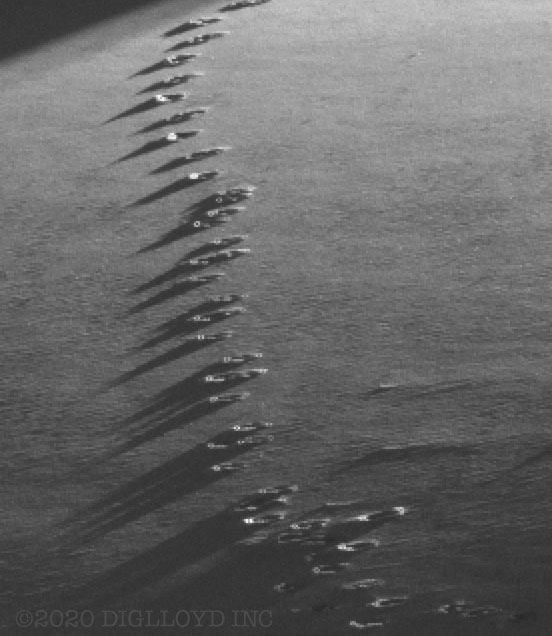Black Dots in White Spots 'Pimples': is Leica 'Cooking' the Raw Data with Acutance-Enhancing Imaging Pipeline? (CONFIRMED by a reader, also REPLICATED with Leica M10-R)
Update: I’ve confirmed this issue using DNGs from a reader, see comment from Brian K that follows near end of post. I had previously looked at quite a few images from his camera and not seen the issue. But with the right subject, the pimples are there in all their ugliness. No prescription yet for how to generate them, but clearly relates to textural detail of sufficient micro contrast. My working theory of Leica oversalting the soup remains top contender. Bittersweet for many fine images I made, all my shooting involved desert and mountain areas, perfect for the manifestation of this ugly image quality bug.

as displayed by RawDigger
Update 2: A/B comparison of the Leica M10-R to the M10M shows that the same issue exists on the Leica M10-R. The demosaicing process makes it a bit harder to see, but an A/B comparison with the same scene shows exactly the same black-dot pimples in exactly the same subject matter locations. This implies that the same raw-file manipulation is going on with both. Presumably, the underlying sensor technology is identical, with the color sensor differing only in its color filter array.
Update 3: RawDigger shows the pimples too, so that makes it definitely an issue with the DNG file, not a raw converter issue. Besides, back in 2015 with the Leica M Monochrom Typ 246 with the same issue, both ACR and CaptureOne Pro both showed the problem.
...
Below, key facts about the exceedingly ugly digital artifacts which I’ve called “Black Dots in White Spots” (sometimes manifesting as white dots in black spots), which I’ll just call 'pimples' here. They have mangled virtually all of my images from my trip.
I cannot unsee these exceedingly ugly spots on my images. Thousands of them pollute some images, often in the most critical areas. This is the most damnning imaging quality defect I have ever seen in a digital camera in my entire career.
Working theory: Leica is 'cooking' the raw DNG file data with some kind of acutance-enhancing imaging pipeline manipulation of the raw data. The result can be tends of thousands of “pimples” all over the image that are the ugly result of this heavy-handed image processing.
- Subject matter matters. The “pimples” are not seen in areas of uniform tone, but tend to occur in subject matter of higher acutance and fine detail.
- The pimples are made-up FAKE detail. It is just not possible to record (except randomly), a black pixel with a white surround. It would take just the right size dark spot aligned just the right way over the photosites, along with all the surrounding pixels to be brighter. Furthermore, diffraction would quickly exert its effects—yet it does not.
- The pimples “stick” to the subject matter. That is, the spots are not fixed in terms of pixel coordinates*. In other words, this does not appear to be a case of “stuck pixels” or “dead pixels”.
- The pimples are invariant with respect to aperture. Every series I shot (many) all confirm that.
- Might it be an imaging pipeline bug, a camera firmware issue? This idea gets credence from seeing the problem in both the Leica M Monochrom Typ 246 and the Leica M10 Monochrome.
Six years or so ago, I reported on an identical problem with the Leica M Monochrom Typ 246. Two very different sensors, yet the identical issue. This implies software (firmware) mangling of the raw data somewhere in the imaging pipeline. When I reported the issue to Leica years ago (including raw files), the company went radio silent on the issue. As far as I can tell, it looks like the same deeply flawed firmware is still in place. If Leica wants to speak to the issue and its mangling of my images, then I’m all ears.
I’ve added a full aperture series to my page covering this issue:
Leica M10 Monochrom: Black Dots on White Spots Digital Artifacts

Leica M10 Monochrom + Leica 28mm f/1.4 Summilux-M ASPH + filter B+W 090 Red
ENV: Lundy Canyon, altitude 8100 ft / 2469 m, 28°F / -2°C
RAW: vignetting corrected, push 0.5 stops, +100 Shadows, +15 Clarity, +20 Texture, USM {4,50,0}
[low-res image for bot]

Leica M10 Monochrom + Zeiss ZM 35mm f/1.4 Distagon + filter B+W 090 Red
[low-res image for bot]
Brian K writes:
Yup, I now see what you are talking about. They weren’t obvious last night when I looked at the files at 100% [diglloyd: 2020 MacBook Pro 16" with Retina Display, see my comment below]. Became very obvious when zooming in beyond that. And then noticeable (though barely) when I looked at the files at 100% again and knew what to look for.
I’m bummed that they are present—was crossing my fingers it was a camera copy issue. It clearly isn’t.
The good news for me is that I can replicate it in a controlled environment in my basement. So I can experiment to see if I can identify any variables that cause it or accentuate/mitigate it. The bricks, strobe, and tripod remain in place.
I took a few pics without a filter but haven’t reviewed them yet. Also took some with a light red filter. Since I didn’t notice the issue in the worst case scenario, I didn’t bother reviewing those pics. I now need to.
Depending on what those images show, I may shoot a filter series to see if there is a light cutoff value that relates to the artifacts
I also plan to shoot an ISO series to see if there is an ISO value that influences the presence of these artifacts. I recall that the MM had a relatively high base ISO and one of the features of the M10M was that base ISO was lower. I wonder if this could be a compromise Leica accepted in an effort to get the base ISO lower.
I also want to shoot the scene with the SL2 and the same lens. I do not expect to see the pimples, but won’t know until I actually shoot it. May also shoot it with my D850, Z7, and A7RIII. My suspicion is that it won’t show up on these color sensors, but I don’t look at images at greater than 100% and I need to prove to myself that this isn’t a problem in general with this type of scene and is specific to the M10M. Since I now have a controlled setup, seems silly not to be thorough.
Thanks for your replies. Good stuff.
DIGLLOYD: viewing at 100% on a Retina display of about 220 ppi makes the pimples hard to see (at the threshold of the resolving power of the eye—use a display of 110 ppi or so.
I’d bet that there exist no Leica M10M camera bodies that are free of the issue, since my top hypothesis is that it is a firmware signal processing / acutance enhancement behavior, or something of that nature.
If am so sure of myself that I’ll bet a 2-year subscription ($400 value) against any Leica M10M camera body. Anyone who wishes to take me up on the offer can send me their M10M—to become mine when I prove the pimples are there. I don’t expect any takers, but even with its defects, I’ll happily acquire an M10M this way.
Also, I can align a Leica M10-R image shot in an A/B comparison and get a perfect overlay of black spot pimples in the same place for subject matter. The demosaicing blurs things a little and makes it less obvious, but for the same subject matter, the pimples are in exactly the same place.
I do not expect to see the pimples on the Leica SL2 since it is a totally different sensor (without micro lenses AFAIK as well as different resolution and sensor tech), and the firmware might vary accordingly.






























